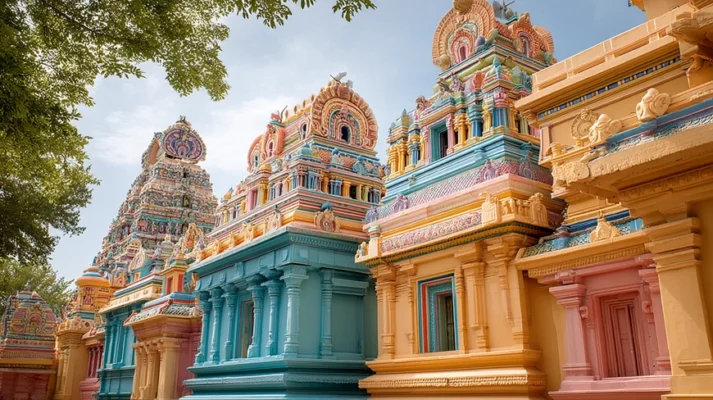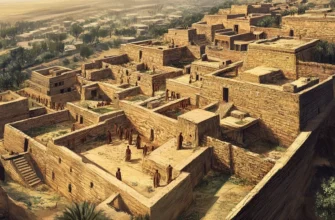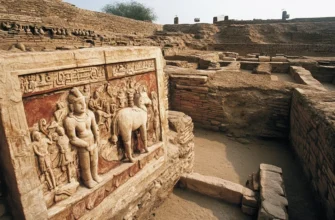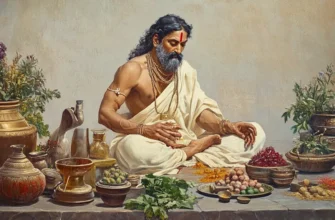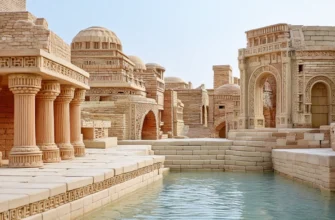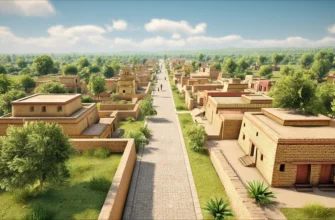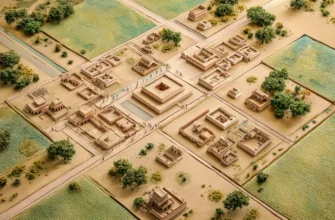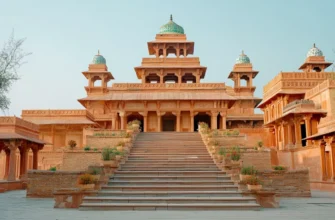Madurai is one of the oldest and most important cities in India, located in the southern state of Tamil Nadu. Founded over 2,500 years ago, the city was an important cultural and religious center in ancient times. Madurai is famous for its history, rich architectural heritage, and deep religious traditions.
The city’s most notable architectural landmark is the Meenakshi Temple, which is not only a religious center but also a symbol of the city. The temple is impressive with its huge mountains, intricate carvings, and bright colors. In addition, Madurai preserves numerous other historical buildings, including ancient palaces and monumental gates.
The city has played an important role in the development of Indian culture, art, and literature. During the reign of the Pandya dynasty, Madurai was the cultural capital of South India. The city is also famous for its festivals, the largest of which is the Meenakshi Tirukkalian festival, which attracts thousands of pilgrims from all over the country.
Today, Madurai combines ancient traditions with modern development. The city is not only an important cultural center but also a popular tourist destination that attracts tourists seeking to immerse themselves in the atmosphere of ancient India.
History of Madurai
Madurai has an extremely rich and ancient historical heritage dating back over 2,500 years. The city became an important political, religious, and cultural center of South India, particularly during the reign of various dynasties.
The origins of the city and its foundation
According to legend, Madurai was founded by the god Shiva, who gave the city its unique structure. Archaeological finds indicate that the city existed as early as the 4th century BC. Its strategic location on the Vayagai River allowed it to control important trade routes between different parts of India.
Madurai has deep roots in Indian history, and its founding is shrouded in legends and myths. According to one of the most widespread legends, the city was founded by the god Shiva. One story says that Shiva created the city on his throne when he came to this region to unite with the goddess Meenakshi. This union became the basis for the founding of Madurai.
There is also archaeological evidence that the city was founded as early as the 4th century BC. The early history of Madurai is marked by trade links with other civilizations, including Persia and the Roman Empire. An important factor in the city’s development was its strategic location on the Vayagai River, which allowed it to control trade between different parts of India.
During this period, Madurai quickly became an important cultural and religious center. During the reign of the Pandya dynasty, the city flourished, becoming one of the major centers of India, where trade, religion, art, and culture thrived.
Madurai’s role in the history of South India
Madurai gained its fame thanks to the Pandya dynasty, which ruled the city for over a thousand years. Under their rule, the city became an economic and cultural hub where trade, art, literature, and religious life flourished. The Pandya dynasty was known for its support of Hinduism and contributed to the development of numerous temples, the most significant of which is the Meenakshi Temple.
Madurai played an important role in the history of South India, becoming a significant cultural, religious, and political center over the centuries. Its strategic location on the Vayagai River allowed it to control important trade routes and also became the basis for the city’s development as an important trading hub.
Role during the Pandya dynasty: Starting in the 3rd century BCE, Madurai became the capital of the Pandya dynasty, one of the most famous ruling dynasties of South India. Under their rule, the city achieved significant prosperity, becoming an important cultural and economic center. Madurai was famous for its temples, art, literature, and science. The Pandya rulers supported the Hindu religion, and the Meenakshi Temple, which became a symbol of the city, was built during this period and played a key role in religious life.
Madurai’s role as a cultural and religious center: Madurai became an important center of Hindu culture, art, and literature. Religious ceremonies and festivals flourished here, as did a large number of poets and scholars. The city became a place for the development of a large number of art schools and literary traditions, such as Tamil poetry and theater. In addition, numerous religious celebrations, including the Meenakshi-Tirukaliyan festival, attracted people from all over India.
Madurai’s political role during other dynasties: Madurai also had strategic importance at various periods in history, particularly during the reign of the Chola, Chera, and other southern dynasties. The city remained a political center in the region even after the fall of the Pandya dynasty. Madurai not only became a cultural center, but also served as a trading and military hub.
Thus, Madurai played a key role in the history of South India as an important center of culture, religion, art, and politics, influencing the development of the entire southern region of India.
Madurai during the reign of various dynasties
After the fall of the Pandya dynasty in the 13th century, Madurai came under the rule of other dynasties, including the sultans and the Portuguese. Since then, the city has undergone periods of cultural and political change. However, during the rule of the Naga dynasty in the 15th-16th centuries, Madurai was reborn as an important cultural center of India.
Due to its strategic location and importance, Madurai has been ruled by various dynasties throughout its history. Each of these dynasties left its mark on the cultural, religious, and political development of the city.
The Pandya Dynasty (3rd century BCE – 13th century CE)
The Pandya dynasty was one of the largest and most famous ruling dynasties of South India. Madurai was the capital of this dynasty for many centuries. During the reign of the Pandya dynasty, the city became a thriving commercial, religious, and cultural center.
This was a period of tremendous development of Hindu religious culture, thanks in particular to the construction of the Meenakshi Temple, one of the largest and most famous temple complexes in India.
Under the rule of the Pandya dynasty, Madurai also became a center of literature and art, where both religious and secular traditions flourished, including poetry, music, and painting.
The Chola Dynasty (9th–13th centuries)
After the fall of the Pandya dynasty in the 12th century, the city came under the influence of the Chola dynasty. This was a period when Madurai became an important strategic point for the Chola, as the Chola dynasty sought to expand its territories in the southern regions of India.
During the Chola period, architecture and culture also flourished in Madurai. Although the capital of the Chola dynasty was in Tanjavur, Madurai remained an important commercial and cultural center south of the main Chola territory.
The Vellala Dynasty (14th–15th centuries)
In the mid-14th century, Madurai became part of the Vellala state, which was a powerful force in South India. This dynasty strengthened Madurai’s infrastructure, promoted the development of agriculture, and expanded trade. The Vellalas also continued to support religious and cultural traditions, laying the foundations for the development of various religious and artistic movements.
Muslim rulers (14th–16th centuries)
In the mid-14th century, when Muslim sultans from Delhi invaded South India, Madurai came under the control of Muslim rulers, particularly the Sultanate of Madurai, which was part of the larger Delhi Empire.
This period was difficult for Madurai, as the city suffered numerous conquests and the destruction of temples.
The Nagai Dynasty (15th–17th centuries)
At the end of the 16th century, after a period of Muslim rule, Madurai came under the control of the Nagai dynasty. This was a period of cultural and religious revival in the city. The Nagai actively restored and expanded temples and promoted the development of literature, art, and science. The city once again became an important cultural and religious center of South India.
British rule (19th–early 20th centuries)
In the 19th century, Madurai fell under British colonial rule. This was a period of significant change in the city as the British introduced new administrative and economic reforms. Madurai became an important center of trade, and its economy developed thanks to the production and export of goods such as cotton and spices.
Throughout its history, Madurai has changed rulers many times, but it has retained its strategic, cultural, and religious significance. Each dynasty left its mark on the city’s history, contributing to its development as an important center of Hindu culture, art, and trade.
Madurai today
Despite numerous conquests and changes throughout its history, Madurai has remained a symbol of cultural heritage and the Hindu religion. Today, it is one of the most important cities in South India, preserving traditions and monuments that bear witness to its great history.
Madurai today is a striking example of the combination of ancient culture and traditions with modern achievements. The city retains its religious and cultural significance, while also actively developing economically and in terms of infrastructure. Therefore, Madurai not only attracts tourists, but is also becoming an important business center in southern India.
Architecture and cultural heritage
Madurai’s architecture and cultural heritage are important aspects that define the uniqueness of this city. Madurai is rightly considered one of the cultural centers of India thanks to its rich history, numerous temples, palaces, and magnificent architectural monuments that have become symbols of its heritage.
Meenakshi Temple — the heart of Madurai
The most famous architectural landmark of Madurai is the Meenakshi Temple, one of the most important religious and cultural monuments in India. Dedicated to the goddess Meenakshi and her husband Shiva, the temple impresses with its grandeur in the city center. Its construction began during the reign of the Pandya dynasty, but many parts of the temple were completed or expanded at various stages of its history.
The temple consists of huge gates called gopurams, covered with colorful sculptures of gods, goddesses, and mythological creatures. Each gaopura is a separate architectural masterpiece, with bright colors and intricate carvings. The tallest gaopura reaches a height of 52 meters, making the temple one of the tallest in India.
Other important temple complexes
In addition to the Meenakshi Temple, Madurai has several other important religious architectural monuments. These include:
Tulmal Iya Temple: This is another large Hindu temple, known for its architectural details and location on the right bank of the Vayagai River. The temple preserves traditional Hindu styles of construction.
Kuttalappa Temple: Also part of Madurai’s religious heritage, this temple is famous for its huge carvings and magnificent facades.
Palaces and ancient buildings
Madurai is not limited to temples. The city has a rich architectural tradition, including ancient palaces and buildings that served as residences for rulers. One such palace is the Nayya Palace. Although most of the palace buildings have not survived to this day, its ruins bear witness to the grandeur and luxury of the past.
Another important site is the Thalaittiratta Valakam Palace, which showcases the wealth of architectural styles characteristic of Madurai in the Middle Ages.
Art, literature, and culture
Madurai’s cultural heritage is much more than just architecture. The city is a hub for traditional Hindu festivals and celebrations, such as the annual Meenakshi Tirukkalyanam festival, which is an important part of the city’s religious and cultural life.
The literature and poetry of the Tamil region also have a long history in Madurai, and the city has become an important center for the creation of a large number of classical poetic works.
Contemporary architectural changes
Despite its rich architectural heritage, Madurai is also actively developing in a modern direction.
In recent decades, the city has undergone a period of modernization, with new buildings combining contemporary architectural forms and traditional elements. Modern shopping centers, hotels, and other buildings coexist harmoniously with historical monuments, giving the city a unique look that blends the old and the new.
Madurai’s architecture and cultural heritage are a wonderful reflection of India’s rich history and cultural traditions. The temples, palaces, and other architectural monuments of this city are a testament to how deeply rooted Hindu religion, culture, and art are in the life of Madurai.
Religion and religious traditions
Religion and religious traditions are central to Madurai’s life and are one of the main reasons for its cultural and historical significance.
Madurai, as an important religious center in South India, maintains deep ties with Hinduism and is home to numerous shrines, temples, and religious practices that have shaped its identity over the centuries.
Hinduism as the main religion
Hinduism is the main religion of Madurai, and the city is an important center of Hindu spirituality in South India. Many of the temples and shrines in Madurai are dedicated to various gods and goddesses of the Hindu pantheon, including the goddess Minakshi and the god Shiva. These temples are not only places of prayer and worship, but also play an important role in the social and cultural life of the city.
Meenakshi Temple — the heart of religious life
The most famous religious tradition in Madurai is the worship of the goddess Minakshi, who is the main goddess of the city. The Minakshi Temple, one of the most famous religious buildings in India, is not only an architectural landmark but also a center of Hindu religious practice. Every year, millions of pilgrims and tourists visit the temple to worship the goddess and her husband, Lord Shiva, who also has his own temple complex in the area.
Religious festivals and celebrations
Madurai is famous for its religious festivals, which are important events for locals and pilgrims alike. The largest and most important festival is the Meenakshi Tirukkalianam, which takes place every year at the Meenakshi Temple. This grand festival includes solemn processions, religious rituals, dances, musical performances, and other cultural events that reflect the rich traditions and beliefs of the local people.
In addition, Madurai celebrates many other religious events, such as Tamil festivals and other Hindu holidays associated with various deities. These festivals are often accompanied by songs, dances, and religious rituals that strengthen spiritual bonds within the community.
Worship and veneration of Shiva
Like many other cities in India, Madurai is also an important place of worship for the god Shiva, who is one of the main deities in Hinduism.
Many temples in Madurai, such as the Meenakshi Shiva Temple, contain numerous statues and sculptures of this god, and religious ceremonies and festivals dedicated to Shiva are held. One such important festival is Maghasarathi, a day when Shiva is honored in various temples throughout the city.
The importance of rituals and ceremonies
Religious rituals in Madurai are of great importance in the daily life of the inhabitants. From morning to evening, numerous prayers and pujas (worship ceremonies) are performed both in temples and at home.
These rituals can be either individual or collective, and they are an important part of the social and cultural fabric of the city. The rituals are accompanied by hymns, songs, and music, which help to create an atmosphere of festivity and spirituality.
The influence of Hinduism on culture and art
Hinduism, particularly the cult of Meenakshi, not only defines the religious life of Madurai, but also deeply influences the city’s art, music, dance, and literature. Professional dancers and musicians participate in religious festivals, performing traditional Indian dances and songs that usually tell mythological stories and divine exploits. Painting and carving are also actively practiced in Madurai, particularly in the context of religious themes such as depictions of gods, goddesses, and mythological scenes.
Other religious groups
Although Hinduism is the main religion in Madurai, the city is also home to various smaller religious groups, including Muslims, Christians, and Buddhists. Their shrines and traditions add even more diversity to the city’s spiritual landscape.
This is a testament to the fact that Madurai, while a deeply Hindu city, has a multicultural and interfaith character.
Religion and religious traditions are at the heart of Madurai. The city maintains deep roots in Hinduism through its numerous temples, festivals, and religious practices, which have shaped its unique cultural identity over the centuries. Madurai’s religious life not only unites its inhabitants but also attracts thousands of pilgrims and tourists seeking spiritual inspiration and a deeper understanding of Hindu culture.
Conclusions
Madurai is an important symbol of India’s cultural heritage and history, combining a thousand years of history, religious traditions, and cultural heritage.
This city, which has gone through various stages of development, from its founding in ancient times to periods of rule by great dynasties such as the Pandya, preserves traces of a rich history that encompasses not only political and economic development but also a huge contribution to culture and science. Madurai was an important center for trade, art, and religion, and it was here that the foundations of many traditions that are still preserved today were laid.
The city’s architectural monuments play a particularly important role in its cultural heritage, among which the Meenakshi Temple is the most famous. This temple is not only an architectural masterpiece but also a spiritual center where numerous religious ceremonies and celebrations take place, attracting millions of pilgrims from all over the world. Madurai not only preserves ancient traditions but is also a living testimony to how religious practices and cultural customs are combined. Festivals such as Meenakshi Tirukkalyanam and other religious ceremonies are not only important events for the city but also have an impact on the wider cultural community of India.
Today, despite its centuries-old history, Madurai is actively developing. The development of infrastructure, tourism, and the economy has not led to the neglect of its cultural heritage. The city continues to attract tourists and pilgrims who come to see both historical monuments and modern achievements. Madurai is a wonderful example of how ancient culture and modern development can coexist, preserving the importance of their roots while adapting to the changes of the modern world.
